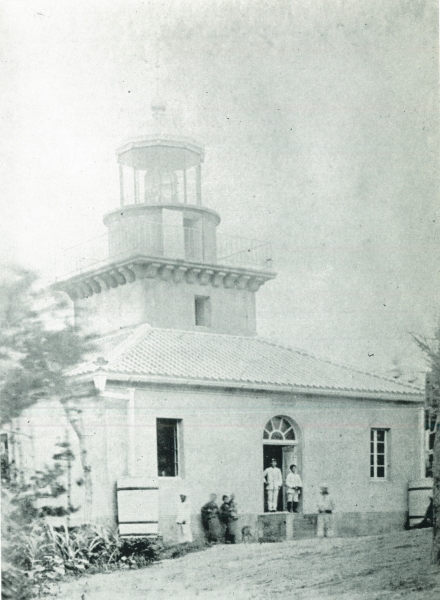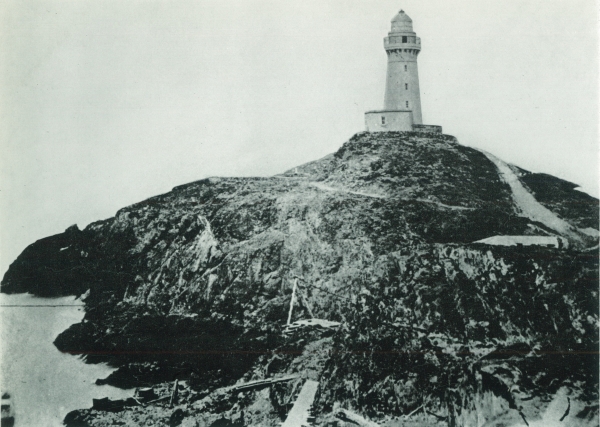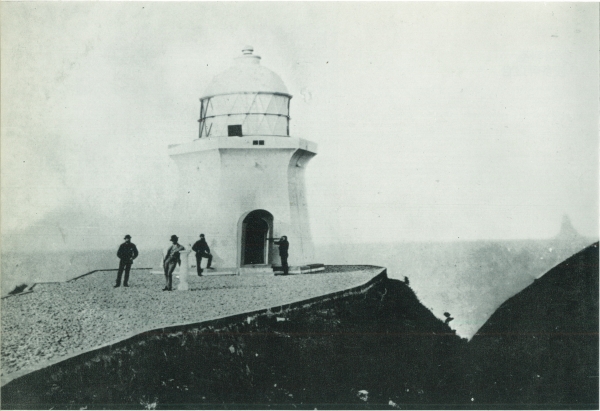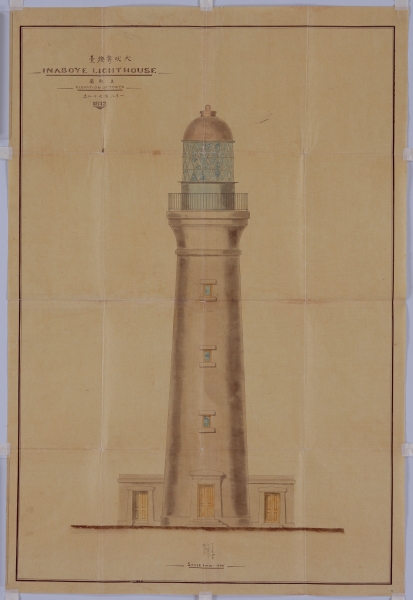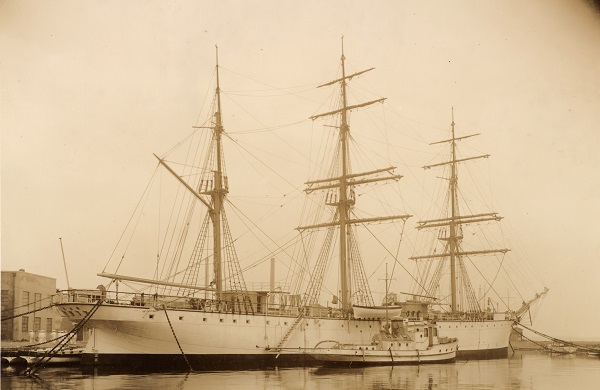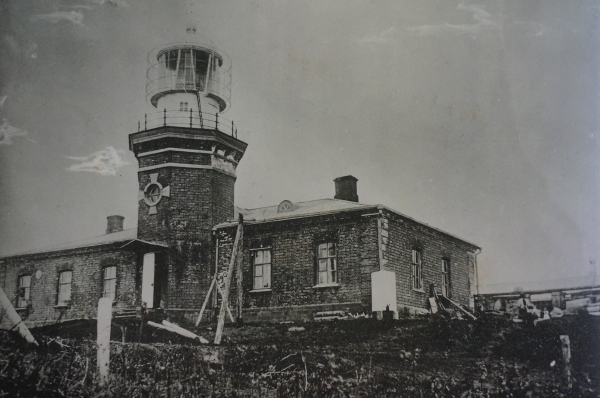
Top Page > Viewing Meiji Japan's Engagement with Asia through the Archives > Column1 [ 明治の燈台建設と東アジア ]
Column No.1 [ Lighthouse Construction During the Meiji Period and East Asia ]
Introduction
Lighthouses preserve safety on the seas. Even today, when technologies such as global-positioning systems have been developed that can accurately determine geographical information, the important role that lighthouses (tōdai) play remains unchanged.
Many of the Western-style lighthouses that can be seen around Japan today were built after the Meiji Restoration.
In this Column, we look at the historical background behind the construction of these lighthouses during the Meiji period, the activities of foreign advisors, and the connections between their construction and the countries of East Asia.
1. Japan's "Opening" and Lighthouses
As the foregoing remarks indicate, Japan built a series of Western-style lighthouses in the years following the Meiji Restoration. However, prior to the introduction of those modern structures, facilities of an older type—namely, old-style lighthouses known literally as “lantern towers” (tōmyōdai) that provided illumination with oil-filled lanterns—were used around the archipelago.
The primary objective of building these lantern towers was the expectation that they would allow for safe navigation. However, the oil-fueled lanterns could illuminate only areas close at hand, and it is said that numerous accidents occurred while traveling at sea.
The roles these lantern towers played were likely not just to warn vessels that they were passing through a dangerous area, but also to serve as prayers for safe passage and to console the spirits of those who died in accidents .(Tanigawa 2016)
The first steps toward building modern, Western-style lighthouses that use lenses to shine lights to points farther away were taken toward the end of the Edo Period (1601-1867).
The Article 11 of the Tariff Convention between Japan, France, Great Britain, Netherlands and the United States of America concluded on June 25, 1866, clearly specified that Japan would “provide all the Ports open to Foreign trade with such lights, buoys and beacons as may be necessary to render secure the navigation of the approaches to the said Ports.”
In 1866, discussions took place among the representatives of various countries with British Ambassador Harry Smith Parkes at the center. These discussions resulted in a request to the Tokugawa bakufu that lighthouses be erected in 10 locations: Cape Tsurugi, Cape Kannon, Cape Nojima, Mikomoto Island, Cape Kashino, Cape Shiono, Cape Sata, Iō Island, Honmoku, and Hakodate (the facilities at the latter two would be lightships).
On November 9, 1867, the head of the Yokosuka Iron Works—French naval engineer François Léonce Verny—surveyed the locations around Edo (Tokyo) Bay where lighthouses were to be constructed and added two more locations at Jōgashima Island and Shinagawa Battery No. 2. The bakufu then formally requested that Verny construct the lighthosues at Kannon, Nojima, Jōgashima, and Shinagawa.
Soon thereafter, the Tokugawa regime was supplanted by the new Meiji government, but Verny nonetheless remained in charge of building the four aforementioned lighthouses. The design of the structures is said to have been overseen by Louis Felix Florent, chief of the Yokosuka Iron Works’ Construction Section.
Thus, the first lighthouses were constructed by a team of French engineers.[Image 1]
Responsibility for lighthouse construction thereafter passed from the hands of those Frenchmen to a group of engineers dispatched by Great Britain, with the lead role played by Scottish engineer Richard Henry Brunton.
Brunton was responsible for the building of lighthouses in 30 locations, including the ones at such places as Cape Kashino (eastern tip of the island Ki-ōshima), Mikomoto Island (off Shimoda), Esaki (northern tip of Awaji Island), Cape Iōjima (the mouth of Nagasaki Harbor), Cape Sata (southern tip of Kagoshima's Ōsumi Peninsula), Mutsure Island (western mouth of the Shimonoseki Straits), and Cape Inubō (eastern tip of Bōsō Peninsula)[Image 2-4]. He was also active in working to train people in lighthouse construction.
In his memoirs, Brunton writes in detail about such topics as taking measurements from the lighthouse supply ships Sunrise and Thabor, and about negotiations with the Meiji government.
2. Changes in the departments overseeing lighthouse affairs
As noted above, based on Article 11 of the Tariff Convention that the Tokugawa bakufu signed with the great powers of the day, that government was obliged to put navigational aids into place for ship safety reasons.
Elder (rojū) and lord of Suō Province Matsudaira Yasuhide was put in charge of lighthouse affairs at the end of the Edo period. He was also appointed to the concurrent posts of gaikoku bugyō ("magistrate of foreign affairs") and Kanagawa bugyō ("magistrate of Kanagawa Province").
After the Meiji Restoration, jurisdiction for lighthouse matters was transferred to the Foreign Office. However, in actual fact it was the Yokohama Court—created from the Meiji government's enforced reorganization of the former Kanagawa Magistrate's Office, it was later renamed the Kanagawa Prefecture Court—that oversaw the lighthouses.
In 1868, a Lighthouses Subsection (Tōmyōdai-kakari) was created in the Kanagawa Prefecture Court, and it began selecting locations where lighthouses were needed and handling the business of construction. Subsequently, however, responsibility for supervising lighthouse affairs would change hands at a bewildering pace.
First, on February 26, 1869, jurisdiction over the Lighthouse Subsection was transferred to Accounts Office (predecessor the Ministry of Finance). Then, that May 17, it was transferred back to the Foreign Office and renamed the Lighthouse Office (Tōmyōdai-yakusho).
However, the actual offices for this unit remained in Yokohama's Benten neighborhood. This location would remain the center of activity in the management of Japanese lighthouse affairs.
Three months later, on August 15, the Ministry of Foreign Affairs was created. On October 22, the Lighthouse Office was transferred to the Ministry of Finance and its name was changed to Lighthouse Bureau (Tōmyōdai-kyoku).
The following August 9, the Lighthouse Bureau was transferred to the Ministry of Civil Affairs, and then on December 12, 1870, it was moved to the newly created Ministry of Industry.
On June 27, 1871, the bureau was reorganized again into the Lighthouses Subsection (Tōmyōdai-kakari) and Sano Tsunetami, vice junior officer of public works, was put in charge of the section as the Lighthouses Chief (Tōdainokami).
From this point forward, the business of administering lighthouses would move away from Kanagawa Prefecture and completely come under the purview of the Ministry of Industry.
On September 28, 1871, the Lighthouses Subsection was reorganized into the Lighthouse Board (Tōdai-ryō). This name lasted until January 11, 1877, when it once again became the Lighthouse Bureau.
This came at what could be described as a transitional period, for Brunton had been discharged from his duties in March 1876 and Japanese engineers were now becoming central to overseeing lighthouse operations.
During the Ministry of Industry era, Fujikura Kentatsu, Ishibashi Ayahiko, and other figures of later note would be trained as lighthouse engineers. Fujikura himself would appointed chief of the ministry's Lighthouse Bureau on May 25, 1885.
With the disbanding of the Ministry of Industry on December 22, 1885, lighthouse operations were transferred to the Ministry of Postal and Telecommunications.
Fujikura spent a few months as inactive status awaiting a new appointment with the Ministry of Industry's closure before he was once again appointed chief of the Lighthouse Bureau under the Ministry of Postal and Telecommunications on March 3, 1886.
During his career, Fujikura frequently boarded the lighthouse supply vessel, Meiji-maru, and he had visited and observed Lighthouses in various places in Japan.
※Meiji-maru constructed for the Japanese government in September 1874 by Robert Napier and Sons Shipyard (Glasgow, Scotland). She arrived at Yokohama in February 1875. Now, Meiji-maru is preserved at Tokyo University of Marine Science and Technology.
On August 16, 1891, the Lighthouse Bureau was consolidated with the Ministry's Vessel Bureau, while the Ministry also created a separate Marine Navigation Beacon Control Center.
The Marine Navigation Beacon Control Center was responsible for navigation beacon construction and handling affairs related to those beacons' maintenance.
The Ministry of Postal and Telecommunications was also home to such other bodies as the Committee to Study Sea-Lane Marker Positioning and the Telegraph and Lighthouse Supplies Factory. It would be safe to say that the Ministry had a structure under its jurisdiction that permitted it to systematically handle the siting, construction, and management of lighthouses.
3. The Administration of Japan's Colonies and Lighthouses
New aspects to Japan's building of lighthouses came into play after the First Sino-Japanese War.
Following that conflict, Japan toook on the administration of the Kwantung Leased Territory, Karafuto (Sakhalin), and Korea as its colonies.
Work proceeded on lighthouse construction at these locations as well. The person who was in charge of building lighthouses around the colonies in the early years was the aforementioned Ishibashi Ayahiko.
After the First Sino-Japanese War came to an end, the conditions surrounding the fierce maritime competition that had existed between Japan and Qing China over Korea up to that point changed. With the amount of Japanese maritime traffic headed toward Korean shorelines on the rise, Ishibashi—now an engineer attached to the Ministry of Postal and Telecommunications’ Marine Navigation Beacon Control Center—was dispatched to investigate conditions and so traveled to Korea about the Ministry's lighthouse supply vessel Meiji-maru.
Japan's greater levels of influence over Korea following the conflict with China would seem to lay behind this decision.
In the seventh section of the "Ganghwa Treaty" concluded with Korea after the Ganghwado Incident in September 1875, Japan forceed Korea to allow Japan to freely survey on the Korean coast. It is considered that after the First Sino-Japanese War, Qing's influence against Korea was eliminated and then Japan put into action.
Ishibashi made an exhaustive investigation of the Korean coastline in July and August 1895, and surveyed positions for building lighthouses.
Also, as a consequence of the Treaty of Shimonoseki between Japan and Qing China Japan established a Governor-General of Taiwan and began to run the island as its colony. Following this, on June 24, 1895, the Ad Hoc Taiwan Lighthouse Construction Department was established in the Army Ministry with the objectives of establishing sealanes to Taiwan from Kagoshima to the Southwest Islands and building lighthouses along the way for maritime traffic between Taiwan and the Japanese mainland.
While it was the Army Ministry rather than the Ministry of Postal and Telecommunications that was responsible for lighthouse construction at this time, it was in fact Ishibashi Ayahiko and other engineers of the Ministry of Postal and Telecommunications who handled the job as a commission from the Imperial General Headquarters.
On July 10, 1895, Ishibashi was appointed as an engineer to both the Marine Navigation Beacon Control Center and the Ad Hoc Taiwan Lighthouse Construction Department.
The Ad Hoc Taiwan Telegraph Construction Department was also created in the Army Ministry at the same time, and it helped toward establishing a communications network by laying submarine electric cables. However, it was again engineers of the Ministry of Postal and Telecommunications who played the lead role on this project.[Army Ministry, 1898]
From November 1896 to April 1897, the Ad Hoc Taiwan Lighthouse Construction Department turned on the lights at a string of lighthouses that stretched from the Cape Tsurikake lighthouse at the southern tip of Shimokoshiki Island in Kagoshima Prefecture, to facilities ranging across the islands of Yakushima, Amami, and Okinawa, to the Cape Bitou and Cape Fugui lighthouses located in northern Taiwan.[Image 6-Image 9]
-
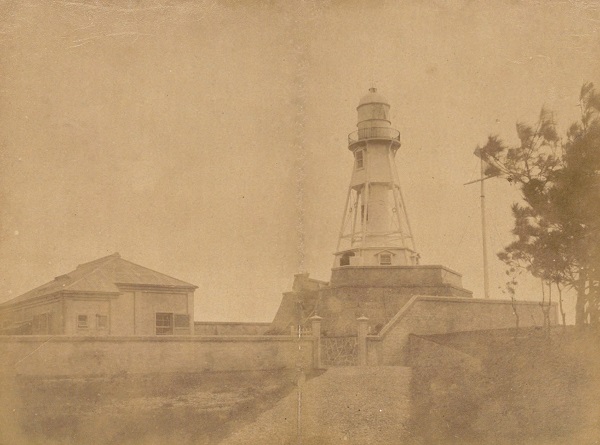
Image 6: Tsuken Island Lighthouse
(国立国会図書館所蔵)
-
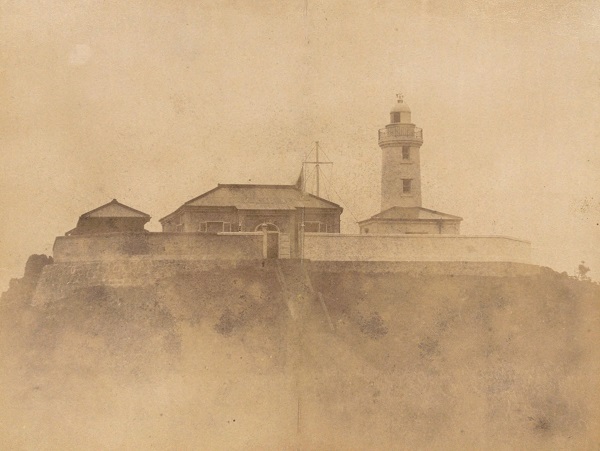
Image 7: Sachibaruzaki Lighthouse
(国立国会図書館所蔵)
-
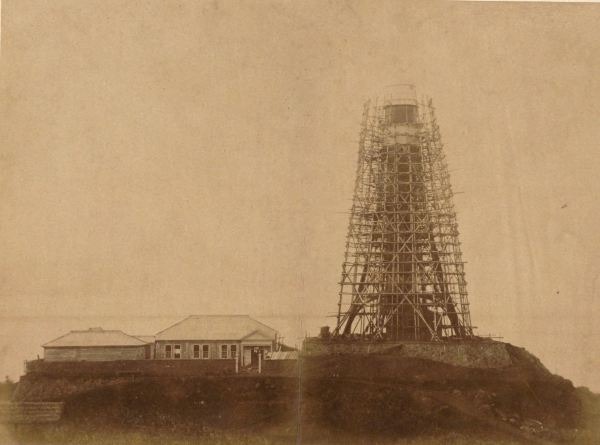
Image 8: Cape Bitou Lighthouse
(国立国会図書館所蔵)
-
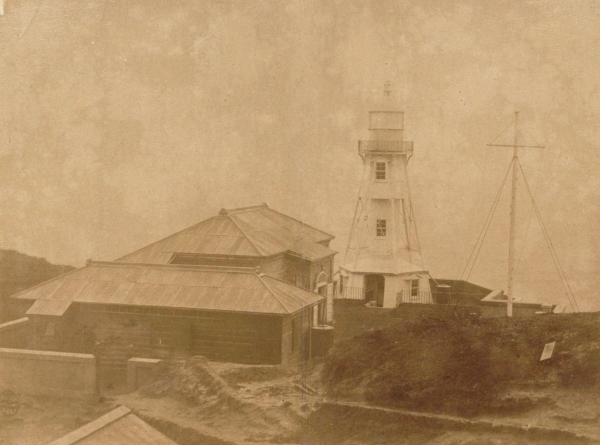
Image 9: Cape Fugui Lighthouse
(国立国会図書館所蔵)
In parallel with this, the Governor-General of Taiwan's Lighthouses Department established on March 30, 1896, took over administration and operation of the Yuweng Island and Cape Eluanbi lighthouses seized from the Qing government that had built them.
In the first decade of the 20th century, as the antagonism between Japan and Russia deepened, the construction of lighthouses around Korea picked up pace.
Responding to an invitation from the Korean government, on November 27, 1901, Japan once again dispatched Ishibashi Ayahiko—now a communications engineer—to the peninsula to handle lighthouse construction.
In June 1903, Ishibashi brought into operation lighthouses on Sowolmi and Wolmi islands in Incheon Harbor.
After conflict broke out between Japan and Russia, he brought online a lighthouse located on the island of Budo in the eastern channel leading into Incheon Harbor. The following month, Ishibashi met with John McLeavy Brown, an Irishman serving as a financial advisor to the Korean government, and presented a plan for building further lighthouses along the Korean Peninsula's coastline to aid Japan's pursuit of its war with Russia.
By the Russo-Japanese War's end, lighthouses had been built at Taehwa Island (off the mouth of Sonchon Harbor in then-North Pyongan Province, brought into operation June 7, 1904), Geomun Island (aka Port Hamilton, South Jeolla Province, brought into operation April 12, 1905), and on Chilbaldo island lighthouse (Naju Islands, South Jeolla Province, brought into operation July 12, 1905).
With the establishment of Resident-General of Korea based on the Second Japan-Korea Convention (aka the Japan-Korea Treaty of 1905) following the Russo-Japanese War, Megata Tanetarō— financial advisor to the Korean Government and chief fiscal auditor of the Resident General of Korea—took the lead on lighthouse construction and numerous such structures went up in succession.
On October 1, 1910, in the wake of its annexation of Korea Japan established the Governor-General of Korea and created within it a Marine Navigation Beacon Control Center that continued the work of lighthouse construction around the Korean Peninsula.
Aside from its structures in Taiwan and Korea, Japan also commandeered and occupied several other lighthouses around the time of the Russo-Japanese War. These included the South Sanshan lighthouse built by Russia in 1930 on South Sanshan Island in Dalian Harbor; a pair of lighthouses built by Qing China and administered by Russia since the Sino-Japanese War—the Liaotieshan lighthouse built in 1893 at Lushun Port (Port Arthur) and the Laohuwei lighthouse built in 1888 on that port’s western side; and the lighthouse at Cape Kondō (later renamed Cape Nishinotoro) on the southern tip of Sakhalin Island.[Image 10]
These lighthouses around Kwantung Leased Territory and Karafuto (Sakhalin) were transferred to the control and operation of the Ministry of Postal and Telecommunications.
As the foregoing illustrates, the construction, control, and operation of lighthouses around East Asia was initimately connected with Japan's war-making efforts and the expansion of its sphere of influence as a result.
Japan’s construction and control of the lighthouses built in its colonies around the region would last until the end of Pacific War.
Conclusion
In the aftermath of the Meiji Restoration, lighthouses lit up the waters around Japan in their role of helping the country's interactions with its regional neighbors.
Subsequently, as Japan expanded its sphere of influence throughout East Asia, they also came to be used as part of the infrastructure for conducting wars and managing colonies.
However, as scholar Tanigawa Ryūichi has pointed out, while lighthouses may be something that a given country builds for its own maritime traffic, they would not be that significant if that was their only purpose. When neighboring countries also build their respective lighthouses and they are all linked together, we can also think of how those lighthouses can create roads on the seas and how they nurture interactions and exchange.
Giving consideration to the fact that these lighthouses have continued to shine out on the seas from the Meiji period to the present day can provide us with a new perspective on viewing relations between Japan and the rest of Asia.
(Taikan Oono, Researcher at JACAR)
(*This essay is based on the author's own opinions and does not represent the official views of the center.)
【 Bibliography 】
- Government of Imperial Japan, Army Ministry, ed. Rinji Taiwan denshin tōhyō kensetsubu hōkoku [Ad Hoc Taiwan Lighthouse Construction Department]. Tokyo: Army Ministry, 1898. (陸軍省編『臨時台湾電信灯標建設部報告』陸軍省,1898年).
- Government of Imperial Japan, Lighthouse Bureau, ed. Nihon tōdai hyō, Taishō 15-nen 5-gatsu kaisei [A list of Japan's lighthouses, revised May 1926]. Tokyo: Lighthouse Bureau, 1926. (燈台局編『日本燈台表 大正15年5月改正』燈台局,1926年).
- Government of Imperial Japan, Marine Navigation Beacon Control Center, ed. Kōro hyōshiki kanrisho dai-san nenpō [Marine Navigation Beacon Control Center 3rd annual report]. Tokyo: Marine Navigation Beacon Control Center, 1911. (航路標識管理所編『航路標識管理所第三年報』航路標識管理所,1911年).
- History of Meiji-maru Editorial Committee, ed. History of Meiji-maru Tokyo University of Mercantile Marine, 1982. (明治丸史編集部会編『明治丸史』東京商船大学,1982年).
- Japan Coast Guard, Lighthouses Division, ed. Nihon tōdai-shi: 100-nen no ayumi [A history of Japan's lighthouses: The course of 100 years]. Tokyo: Tokokai, 1969. (海上保安庁燈台部編『日本燈台史 100年の歩み』社団法人燈光会,1969年).
- Kokaze Hidemasa. Dai-5 shō: Chōsen no shokuminchi-ka to kōtsūmō no keisei" [Chapter 5: The colonization of Korea and the formation of a transportation network]. In Teikokushugi-ka no Nihon kaiun: Kokusai kyōsō to taigai jiritsu [Japan's maritime transport under imperialism: International competition and external self-reliance]. Tokyo: Yamakawa Shuppansha, 1995. (小風秀雅「第5章 朝鮮の植民地化と交通網の形成」『帝国主義下の日本海運 国際競争と対外自立』山川出版社,1995年).
- Noguchi Takeshi and Fujioka Hiroyasu. Raitohausu: Sukutto Meiji no tōdai 64-ki, 1870–1912 [Lighthouses: 64 dashing lighthouses from Meiji times, 1870–1912]. Tokyo: Banana Books, Transview, 2015. (野口毅撮影・藤岡洋保解説『ライトハウス すくっと明治の灯台64基 1870-1912』バナナブックス,2015年).
- Richard H. Brunton, Oyatoi gaijin no mita kindai Nihon. Trans. of "Pioneer Engineering in Japan: A Record of Work in Helping to Re-Lay the Foundations of Japanese Empire (1868–1876)" by Tokuriki Shintarō. Tokyo: Kōdansha gakujutsu bunko, 1986. (リチャード・H・ブラントン(徳力真太郎訳)『お雇い外人の見た近代日本』講談社学術文庫,1986年).
- Tanigawa Ryūichi. Tōdai kara kangaeru umi no kindai [Seas in the modern age considered from the perspective of lighthouses]. Jōhō to fīrudo kagaku 2 [Information and field science no. 2]. Kyoto: Kyoto University Press, 2016. (谷川竜一『灯台から考える海の近代(情報とフィールド科学2)』京都大学学術出版会,2016年).
![Viewing Meiji Japan's Engagement with Asia through the Archives : The External Infrastructure and Network [JACAR Glossary]](../../images/logo.png)
